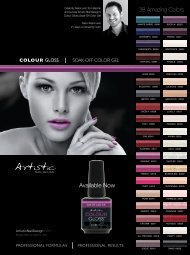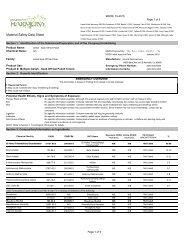Harmony-Gelish Gel Structure - The Nail Depot Supply
Harmony-Gelish Gel Structure - The Nail Depot Supply
Harmony-Gelish Gel Structure - The Nail Depot Supply
Create successful ePaper yourself
Turn your PDF publications into a flip-book with our unique Google optimized e-Paper software.
Extinguishing Media:<br />
Fire Fighting Instructions:<br />
Use carbon dioxide or dry chemical for small fires; aqueous foam or water for large fires.<br />
Remove all ignition sources. Wear self-contained breathing apparatus and complete personal protective equipment when entering<br />
confined areas where potential for exposure to vapors or products of combustion exists.<br />
Unusual Hazards:<br />
High temperatures and fire conditions may cause rapid and uncontrolled polymerization which can result in explosions and the<br />
violent rupture of storage vessels or containers. Avoid the use of a stream of water to control fires since frothing can occur.<br />
Section 6: Accidental Release Measures<br />
Spill or Release Producers:<br />
Spontaneous polymerization can occur. Eliminate ignition sources. Use eye and skin protection. Place leaking containers in a well<br />
ventilated area. Dike and recover large spills. Soak up small spills with inert solids (such as vermiculite, clay) and sweep/shovel<br />
into disposal container. Wash spill area with strong detregent and water solution; rinse with water, but minimize water use during<br />
clean-up. Do not flush to sewer! US Regulations (CERCLA) require reporting spills and releases to soil, water and air in excess of<br />
reportable quantities. <strong>The</strong> toll free number for the US Coast Guard National Response Center is (800) 424-8802. EU Regulations<br />
require the consultation of Directive 98/24/EC. Dispose and report per regulatory requirements if necessary. Please prevent<br />
washings from entering waterways.<br />
Section 7: Handling and Storage<br />
Handling:<br />
Storage:<br />
Explosion Hazard:<br />
Avoid contact with skin and eyes. Avoid breathing vapor. Keep container closed when not in use. Avoid prolonged exposure to<br />
light. Remove all contaminated clothing, shoes, belts and other leather goods immediately. Incinerate leather goods (including<br />
shoes). Wash contaminated clothing thoroughly before reuse. Wash skin thoroughly with soap and water after handling. Solvents<br />
should not be used to clean skin because of increased penetration potential.<br />
Most acrylic monomers have low viscosities, thus only needing room temperature conditions to facilitate proper pouring techniques.<br />
However, viscous type gels such as these may require heating to facilitate proper pouring techniques. To ensure that this happens<br />
product may be heated to 60°C/140°F for not more than 24 hours. Do NOT use localized li heat sources such as band heaters to<br />
heat/melt product. Do NOT use steam. Hot boxes or hot rooms are recommended for heating/melting material. <strong>The</strong> hot box and/or<br />
room should only be set to a maximum temperature of 60°C/140F. Do not overheat, this may compromise product effectiveness<br />
and should be avoided. Refrain from multiple reheating of product, this will also diminishing the quality of the product.<br />
Product is extremely light sensitive. If exposed to natural light, LED, UVA, UVB or UV any light, material will cure very quickly.<br />
Store in a cool, dry place, away from heat and all types of light. Store at temperatures below 100°F/38°C but above<br />
the product's freezing point. If no freezing point is given, keep above 32°F/0°C at all times.<br />
High temperatures and fire conditions may cause rapid and uncontrolled polymerization which can result in explosions and the<br />
violent rupture of storage vessels or containers.<br />
Section 8: Exposure Controls / Personal Protection<br />
Engineering Controls<br />
Personal Protective Equipment<br />
General:<br />
Eye / Face Protection:<br />
Skin Protection:<br />
Respiratory Protection:<br />
Local exhaust recommended to control exposure which may result from operations generating aerosols and hot operations<br />
generating vapors.<br />
To identify additional Personal protective Equipment (PPE) requirements, it is recommended that a hazard assessment in accordance<br />
with the OSHA PPE Standard (29CFR1910.132), or European Standard EN166 be conducted before using this product. Provide eye<br />
wash stations and safety showers. Wear impervious clothing to prevent ANY contact with this product, such as gloves, apron<br />
boots, or whole body suits. Nitrile il rubber is better than PVC.<br />
Wear chemical splash goggles<br />
Wear impervious gloves (Neoprene)<br />
A NIOSH/MSHA approved air purifying respirator with an organic vapor cartridge or canister may be permissible under certain<br />
limited circumstances where airborne concentrations are expected to exceed exposure limits. Protection provided by nuisance<br />
level organic vapor dust masks can be used, however the use of the respirator is limited. Follow OSHA respirator regulations<br />
found in 29 CFR 1910.134 or European Standard EN 149.<br />
Section 9: Physical and Chemical Properties<br />
Appearance<br />
Odor & Odor Threshold<br />
pH<br />
Specific Gravity<br />
Viscosity<br />
%Volatile<br />
Clear to slight violet, viscous liquid<br />
characteristic acrylate odor<br />
NA (H20=1): 1.15<br />
N/DA By Volume:





